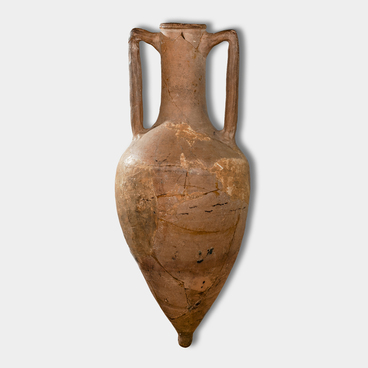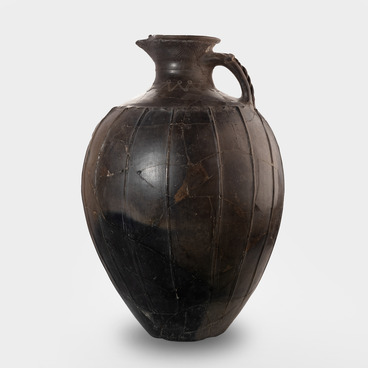The exhibition of the Tanais Archaeological Museum-Reserve features a painted bowl — an artifact dating back to the 3rd century BCE.
The bowl has a dome-shaped design, with its edge beveled inward and featuring a shallow groove. The bottom of the bowl stands on a low circular tray highlighted by a relief groove from the inside. The entire inner surface of the bowl is covered with decorative patterns. Surrounded by concentric relief circles, there is a medallion at the bottom with the image of a child’s head, likely representing Eros. Above this medallion, on the wall of the vessel, there is a strip of white dotted pattern between two concentric white circles. Above that, there is a wide decorative frieze, resembling a wave or some plant, perhaps ivy. The frieze comprises sections of blue and yellow pigment, each with three small circles or ovals in yellow paint at the curve. Another band with a white dotted pattern completes the frieze.
The bowl was obviously very valuable, as confirmed by the presence of 17 small through holes — traces of repairs. The researcher and archaeologist, the candidate of historical sciences Dmitry Borisovich Shelov suggested that the bowls were produced in Asia Minor, specifically in Pergamon. In this region, there were jewelry workshops associated with the technique used for creating relief images on ceramic vessels. Some researchers believe that the production of such ceramics in the 2nd–1st centuries BCE may have started in the centers of the Northern Black Sea Region. This hypothesis is supported by the similarity in the style of ornamentation with other artifacts found in the area and the estimated period to which this bowl belongs.
In general, this painted ceramic bowl is a valuable historical artifact that provides an insight into the skill and taste of ancient Greek people. The intricate ornamentation and traces of repairs indicate that the bowl received special attention and care, reflecting its importance in the culture and art of ancient Tanais.



